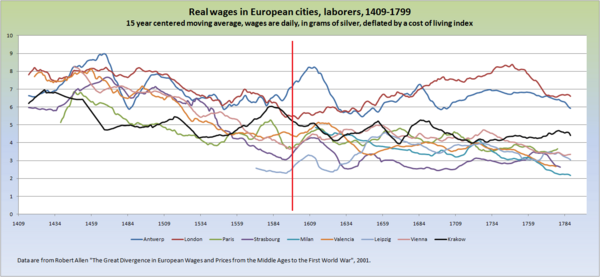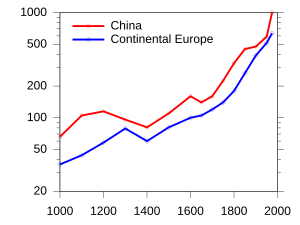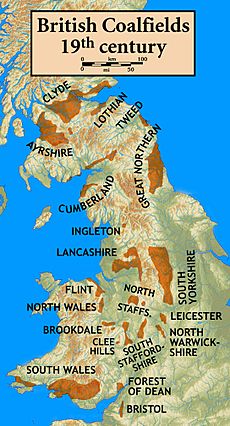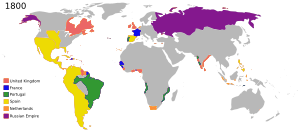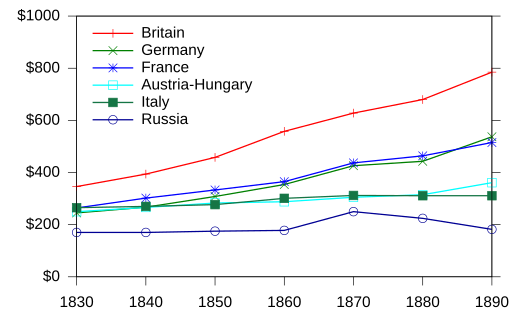Great Divergence facts for kids
The Great Divergence is a big change in history. It explains how countries in the Western world (like Western Europe and parts of the New World settled by Europeans) became super powerful and rich. This happened mostly during the 1800s. Before this, other great civilizations in Asia and the Middle East, like the Ottoman Empire, Mughal India, and Qing China, were just as strong or even stronger.
Historians have many ideas about why this "Great Divergence" happened. Some think it was because of geography, others say culture, or even just chance. The biggest jump in this change happened with the Industrial Revolution in the late 1700s and 1800s. This is when new machines and factories changed everything.
Western Europe used new technologies more than the East. This led to more factories and complex economies. For example, using coal for energy gave Europe a huge advantage. The Great Divergence continued until the 1970s. After that, many developing countries started growing faster. This led to something called the Great Convergence.
Contents
What is the Great Divergence?
The idea of the "Great Divergence" was first used by Samuel P. Huntington in 1996. It became popular with Kenneth Pomeranz's book The Great Divergence: China, Europe, and the Making of the Modern World Economy (2000). Another name for it is the "European Miracle," used by Eric Jones in his 1981 book. Both terms describe how European countries moved far ahead of others in terms of wealth and power during modern times.
Historians don't all agree on when the Great Divergence truly began. Some think it started as early as the 1500s. They believe Europe was already on a path to faster growth then. Others, like Pomeranz, argue that the biggest difference happened in the 1800s. They point out that before then, places like Qing China and Bengal Subah in South Asia had economies similar to Europe's.
Some experts say that cultural reasons for this difference go back even further. For example, the Renaissance in Europe or China's imperial examination system. However, some studies show that by the 1600s, wages in Western Europe were already higher than in the richest parts of Asia. This was especially true for wages measured in silver.
Life Before the Great Divergence
Before the big change, many parts of Europe and Asia had a good standard of living. But they faced limits like not enough land, poor soil, and not enough energy sources. It was hard to keep growing. The Industrial Revolution helped Europe overcome these problems. It allowed for fast and steady growth in wealth for the first time ever.
Western Europe's Journey
After invasions ended around the 900s, Western Europe entered a time of growth. This was called the High Middle Ages. Trade and business grew, and towns became more specialized. But by the 1200s, good farming land was running out. The 1300s brought tough times with famines, wars, and the Black Death.
The Black Death, a terrible plague, actually had some unexpected effects. Because so many people died, there were fewer workers. This meant workers could demand higher wages. It also changed the old feudal system where lords controlled land and people.
A "little divergence" happened within Europe itself. From 1300 to 1800, wages in places like Holland and England stayed high. But in other parts of Europe, like Germany and Spain, wages fell. This meant that Holland and England's economies grew much faster.
During the Age of Discovery, Europeans found new routes to the Americas and Asia. Trade grew even more. New business ideas like joint stock companies (where many people invest together) helped. Countries like the Dutch Republic and Kingdom of England (where Parliament gained power) were better for economic growth.
Some historians, like Jack Goldstone, believe the Great Divergence really took off after 1750 in northwestern Europe. Before that, growth wasn't always steady. The West had unique advantages, like nearby coal mines. Also, the discovery of the New World provided lots of new land and resources. Profits from colonialism also played a part.
China's Story
China has always had a much larger population than Europe. Unlike Europe, China was often united under one government for long periods.
During the Song dynasty (960–1279), China had amazing progress in farming, transport, money, cities, science, and technology. Its economy was the most advanced in the world around 1100. But later, northern China suffered from invasions and disasters. This caused many people and industries to move south. By 1300, China's living standards had fallen behind Italy's. But its richest areas, like the Yangzi Delta, might have been similar to Europe's until the early 1700s.
In the later imperial period (1368–1911), China's economy and population grew a lot. Chinese goods like silk, tea, and ceramics were very popular in Europe. This brought a lot of silver into China. By the late 1700s, China had more big cities than Europe. Kenneth Pomeranz now thinks the Great Divergence started between 1700 and 1750.
India's Economic Journey
India, especially the Bengal Sultanate, was a major trading nation for a long time. It had very good farming and industry. Unlike Europe, India didn't have major deforestation until later. So, it didn't need to switch to coal for energy as early. From the 1600s, cotton textiles from Mughal India were very popular in Europe. Some European governments even banned them to protect their own industries.
In the 1600s and 1700s, Europe really wanted products from India. These included cotton textiles, spices, indigo, and silks. European fashion even started to rely on Indian fabrics. India was so self-sufficient that Europeans had little to sell there. This meant Europeans had to send large amounts of gold and silver to India to pay for goods.
Some studies suggest the Great Divergence between northern India and Britain began in the late 1600s. It grew wider after the 1720s and exploded after the 1800s. This was mainly due to Britain's rapid growth and India's stagnation.
The Middle East's Economy
The Middle East was more advanced than Western Europe around 1000 AD. By the mid-1500s, they were about equal. But by 1750, leading Middle Eastern states like the Ottoman Empire had fallen behind Britain and the Netherlands.
For example, Ottoman Egypt had a strong manufacturing sector in the early 1800s. Its income per person was similar to France's. In 1819, Egypt under Muhammad Ali started building factories for weapons, iron, and cotton. By the 1830s, Egypt had many cotton mills. It was one of the world's top cotton producers. They even used steam engines in their factories.
However, after Muhammad Ali died in 1849, these industries declined. Egypt became more focused on supplying raw cotton to Europe.
Japan's Development
Japanese society was ruled by the Tokugawa Shogunate. This government had strict rules and controlled the economy. It also limited foreign trade. However, Japan still saw economic growth. By 1850, Japan's income per person was about a quarter of Britain's. But surprisingly, 18th-century Japan had a higher life expectancy than England or France.
Sub-Saharan Africa's History
Before European colonization, Sub-Saharan Africa had many different kingdoms and empires. These grew rich from trade along coasts or big rivers. Africa was much less populated than Europe. Some historians believe this lower population made it harder for large, unified states to form. The transatlantic slave trade also weakened African states.
Wealthy kingdoms developed in the Sahel region, profiting from trade across the Sahara Desert. In East Africa, the Kingdom of Aksum had a strong navy and traded with the Byzantine Empire and India. Later, Swahili kingdoms on the east coast were important trading ports in the Indian Ocean.
Why Did the Great Divergence Happen?
Many ideas try to explain why Europe pulled ahead.
The Role of Coal
The Industrial Revolution relied heavily on coal and coke for things like metal production and steam engines. Coal was cheaper and more plentiful than wood. Kenneth Pomeranz pointed out that Europe had coal mines that were easier to access. In China, the biggest coal deposits were far from the main industrial areas.
Britain, for example, had large coal deposits close by. This gave them a big advantage. Some experts argue that coal wasn't the only factor. They say China could have moved its industries closer to coal or imported it.
The New World's Impact
Many theories suggest that Europe's connection to the New World (the Americas) was a major reason for the Great Divergence. Profits from colonies and the slave trade were high. These profits helped Europe invest and grow.
According to Pomeranz, the huge amount of fertile, unused land in the Americas was key. This land could grow food and resources for Europe. This freed up land and workers in Europe for factories. For example, New World cotton and wood saved England from needing millions of acres of its own land. The Americas also became a market for European goods.
Political Differences
Jared Diamond and Peter Watson argue that Europe's geography encouraged many smaller, separate states. Mountains and coastlines created natural borders. China's geography, with its large river valleys, made it easier to unite under one big empire.
In Europe, if one ruler tried to stop new ideas, people could move to a neighboring state. This encouraged new inventions and ways of thinking. For example, Christopher Columbus was turned down by three rulers before Queen Isabella of Spain supported his voyage. In China, if the emperor banned something, it was banned everywhere. For instance, in 1432, the Chinese emperor stopped building ocean-going ships, even though China was a world leader in shipbuilding.
Historian Joel Mokyr says that having many European states meant ideas could spread freely. Scholars across Europe shared knowledge using Latin. This "market for ideas" helped innovation.
Innovation and New Ideas
Starting in the early 1800s, the West became much richer due to new technologies. Things like the railroad, steamboat, and better steam engines changed everything. These inventions helped Europe and the United States become economic leaders.
Some argue that the East's attitude towards innovation was different. They say the East focused on improving existing things, while the West focused on new experiments. The West was more willing to try new things, even if it meant making mistakes. This led to faster progress.
Market Efficiency and Government Rules
Some historians believe Europe had more free and efficient markets than other civilizations. This means it was easier to buy and sell things, and for people to move for work. However, Europe also had things like feudalism and guilds that limited trade. China, for example, had a more open land market.
Economist Paul Bairoch argued the opposite. He said that Western countries like the US and Britain used protectionist policies (protecting their own industries) in the early 1800s. He said the Ottoman Empire had very liberal trade policies, which he believed hurt its own industries.
Wages and Living Standards
Early economists like Adam Smith thought that high wages in the West encouraged new, labor-saving technologies.
Some studies from the late 1900s suggested that living standards in 18th-century China and Europe were similar. They said that life expectancy and food consumption were comparable. Paul Bairoch even estimated that China's income per person in 1800 was higher than Western Europe's.
However, more recent research suggests that parts of Western Europe did have higher wages and incomes than much of India, the Ottoman Empire, Japan, and China in the 1700s. For example, workers in London and Amsterdam could buy much more than workers in Beijing or Delhi.
European Colonialism
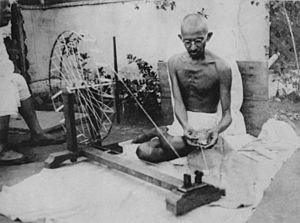
Many historians argue that European colonialism played a big role in weakening industries in non-Western countries. For example, British colonialism in India is often cited. Britain's rule is seen as a major reason for India's industries declining.
Until the 1800s, India was the world's top cotton textile maker. But Britain, through its Industrial Revolution, developed machines to make cotton cheaper. Britain then used its power to open the Indian market to its own goods. It also restricted Indian imports to Britain. India became a source of raw materials for British factories and a market for their finished goods. The wealth gained from India after the Battle of Plassey in 1757 was used to invest in British industries.
Some recent research suggests that colonialism's long-term effects on growth are complex. Nations with more European settlers or longer colonial rule sometimes saw better economic development later on. This was often due to Europeans setting up stronger institutions like property rights.
Culture and Society
Some scholars argue that Western culture, with its focus on experimentation and individualism, helped drive innovation. They contrast this with Eastern cultures, which they claim were more focused on tradition and obedience to rulers. For example, Max Weber argued that the Protestant work ethic in northern Europe helped capitalism grow.
However, many scholars disagree with this view. They point out that Confucianism in China, for example, encouraged questioning authority. Also, merchants in China gained more social status over time and used Confucian ideas in their businesses.
India's caste system is also seen as a factor. It limited economic growth and innovation because it tied people to certain jobs and social levels.
Strong Governments
Some economists argue that governments that represent their people (like in Europe) were better for economic growth. They say that absolute rulers (like in some Eastern empires) could be corrupt and hurt property rights. Governments that were accountable to more people tended to protect property rights better, which encouraged innovation and prosperity.
Globalization's Influence
A 2017 study found that globalization was a major reason for the economic difference between rich and poor parts of the world from 1850 to 1900. Countries with strong limits on executive power benefited most from globalization. These countries could better protect private investments.
The Black Death's Legacy
Historian James Belich suggests that the Black Death in the 1300s set the stage for the Great Divergence. The plague caused mass deaths in Europe. This meant there was more land and resources for the people who survived. The lack of workers led to more use of machines like waterpower and gunpowder. This sped up innovations in things like blast furnaces and ships.
How Did It Change Economies?
The Industrial Revolution completely changed European and American economies. It allowed them to become much wealthier and more productive than other parts of the world. Even when Western technology spread, the way it was used kept the West ahead.
Productivity Boost
Economists use something called "total factor productivity" (TFP) to measure how efficiently countries use their resources. Studies show that Western countries had higher TFP levels in the 1800s. This means they were better at using energy and raw materials to produce goods.
More Income Per Person
One of the clearest signs of the Great Divergence is the rise in per capita income (income per person) in the West. This happened as Western income surpassed that of the East. New transport technologies like railroads and steamboats were key. These made it much cheaper and easier to move large amounts of goods. This greatly increased productivity in the West.
This chart shows how income per person in Western European countries grew quickly after they industrialized.
Changes in Farming
Before and during the early 1800s, farming in much of Europe was not as advanced as in Asia or England. But England had already reached its farming limits. So, the English improved farming by using industrial methods. From 1750 to 1850, Europe's population grew fast. Imports from the Americas helped feed people. Europeans also improved farming techniques and used fertilizers to make their soil better. Meanwhile, places like China struggled to feed their growing populations.
Fuel and Resources
The demand for wood, a key resource for industry, grew in the early 1800s. Western Europe faced wood shortages because they didn't have many forests left. Fuel costs rose sharply. This forced them to use less wood and eventually switch to coal. Coal became a major energy source in Europe in the 1800s. China didn't start using coal on a large scale until around 1900. This gave Europe a huge head start in modern energy production.
China also faced water shortages, especially in the north. This hurt its farming. Growing cotton for textiles, instead of importing it, made the water problem worse.
Trade Advantages
During the age of European imperialism, colonies often specialized in producing specific resources. This helped the colonies for a while, but it also stopped them from developing their own industries. Core countries (like Britain) got cheaper resources through trade with their colonies. This allowed them to grow much faster.
Europe could trade its manufactured goods to its colonies for raw materials. This gave Europe a big advantage. For example, Britain used its control over India to get raw cotton for its factories. Then, it sold finished textiles back to India. This made India a source of raw materials and a market for British goods.
Western Europe also traded profitably with Eastern Europe. Countries like Prussia and Poland had less freedom. Their forced labor provided raw materials for Western Europe.
Guilds and Learning
A 2017 study suggested that medieval European groups like guilds (groups of skilled workers) and the practice of journeymanship (traveling to learn a trade) helped Europe rise. These systems were good at creating and sharing knowledge. This helped the Industrial Revolution happen in Europe.
See also
- Colonial empire
- Industrial Revolution
- Economic history of China before 1912
- History of Western civilization
- Modern history
- Textile manufacture during the British Industrial Revolution
- Western empires
Books to Explore
- Civilization: The West and the Rest
- The European Miracle
- The Great Divergence: China, Europe, and the Making of the Modern World Economy
- Guns, Germs, and Steel
- Why the West Rules—For Now
Images for kids


